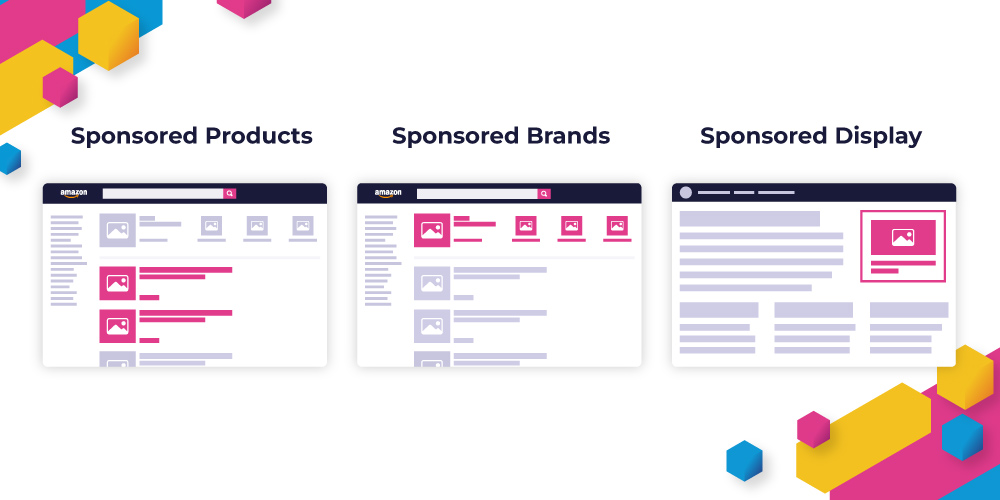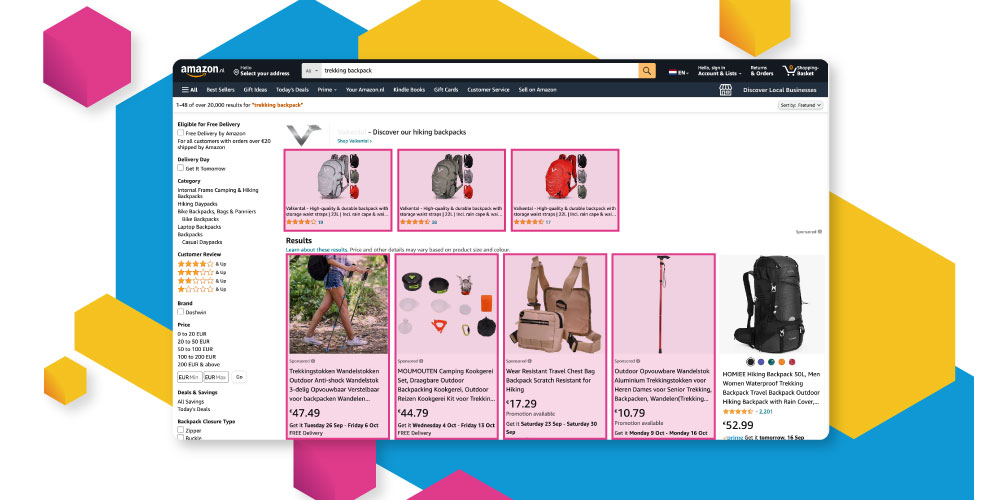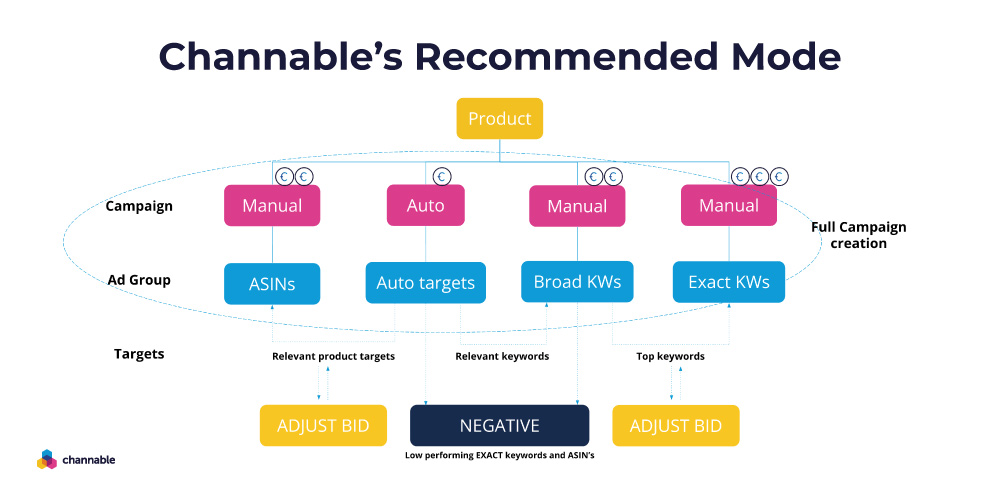Best Practices for Creating Amazon Ads


Amazon Ads have emerged as a powerful tool for businesses looking to reach potential customers across the eCommerce landscape. To shed light on effective Amazon Ads strategies, we sat down with Jochem Timmers, one of Channable's seasoned product experts. In this interview, Jochem discusses the nuances of Amazon Ads best practices, from marketing strategies to campaign structures, helping businesses enhance their online presence and boost sales.
Amazon Ads marketing strategies: best practices with Jochem Timmers
Amazon Ads have become an indispensable tool for businesses seeking to expand their reach within the eCommerce landscape. On this topic, we had the privilege of sitting down with Jochem Timmers, Amazon Ads product owner at Channable, to delve into the realm of Amazon Ads best practices.
From marketing strategies to campaign structures, Jochem shared invaluable insights that can empower businesses to enhance their online presence and bolster their sales, so let's jump on in.
Benefits of Amazon Ads
Q: Can you explain the key differences between Amazon Ads and other major advertising platforms like Google Ads or Facebook Ads?
A: Amazon Ads differ from platforms like Google Ads and Facebook Ads in that they are tailored specifically for the Amazon marketplace.
While Google and Facebook ads target users at various stages of their online journey, Amazon Ads focus on users who are already in a purchasing mindset. Amazon Ads are displayed within Amazon search results and product pages, increasing the likelihood of conversions.
Q: What are the main types of Amazon Ads, and how do they cater to different marketing goals?
A: The main types of Amazon Ads are Sponsored Products, Sponsored Brands, and Sponsored Display.
-
Sponsored Products are the most used, with around 80% of ad spend going to this type of ad, it promotes individual product listings and is keyword-targeted.
-
Sponsored Brands is exclusively for brand owners and promote a brand or product range, featuring a custom headline, logo, and products.
-
Sponsored Display reaches customers both on and off Amazon, using targeting options based on interests and behaviors.
Q: How important is keyword research in Amazon Ads, and what tools or best practices do you recommend for effective keyword research?
A: Keyword research is crucial in Amazon Ads to ensure your ads appear for relevant search queries.
Tools like Amazon's own "Amazon Keyword Tool" and third-party tools like Helium 10, and Jungle Scout can help identify high-converting keywords.
Consider competitor analysis and monitoring search terms in campaign reports for refinement. Once you know which ads are performing well, Channable can help you boost them even further with Rules to focus and increase ad spend for more visibility and sales.
Q: Can you discuss the concept of "Product Targeting" in Amazon Ads and provide an example of how it can be used effectively?
A: Best practices for "Product Targeting" involve displaying your ads on specific product detail pages. For instance, if you sell a brand of hiking boots, your ad could appear on a related hiking backpack's detail page.
This method leverages complementary or competitive products to reach a relevant audience and with automation rules can be a very effective way of targeting with your ads.
Q: How does Amazon's algorithm determine the placement of ads on the platform? What strategies can advertisers use to improve their ad placements?
A: Amazon's algorithm determines ad placements based on relevance and bid amount. Advertisers can improve placements by optimizing keywords, targeting, and bids. High-performing ads and products often receive better placements due to increased conversions and relevance.
Q: What role does product content optimization play in Amazon Ads? How can advertisers enhance their product listings for better ad performance?
A: Product content optimization directly impacts ad performance. High-quality images, clear titles, informative bullet points, and engaging product descriptions enhance both organic and ad-driven traffic.
Optimizing content improves the likelihood of conversions once users reach the product detail page. All of this can be optimized and organized with a solution like Channable.
Q: How does audience targeting work on Amazon Ads? What are some best practices for identifying and reaching the right audience for a product?
A: First of all it's good to state that audience targeting is only possible with Sponsored Display ads. Audience targeting on Amazon Ads involves refining targeting based on demographics, interests, and behaviors.
Best practices include analyzing past customer data, utilizing Amazon's targeting options, and leveraging third-party data sources for more granular audience segmentation. For Sponsored Products and Sponsored Brands, keywords and product targets are the only targeting methods.
Q: Can you discuss the concept of "Sponsored Brands" and explain how it differs from other Amazon ad formats?
A: "Sponsored Brands" are ads that promote your brand and product range and are only available to brand owners. They appear at the top of search results and allow you to direct shoppers to a custom landing page or Amazon Store.
Sponsored Brands are more focused on brand awareness and consideration compared to product-focused Sponsored Products.
Q: Amazon offers both manual and automatic targeting options for campaigns. When would you recommend using each approach, and what are the advantages of each?
A: Manual targeting is recommended when you want precise control over targeting, such as bidding on specific keywords or products. This method can be a great choice when you know which of your ads are performing best and want to boost their performance further with specific targeting.
Automatic targeting is useful for gathering data on converting search terms. Manual campaigns require ongoing optimization, while automatic campaigns leverage Amazon's algorithms for targeting.
This can be a good way to launch a campaign and gather data to see which ads and products are performing well, before moving them to a manual campaign for more specific targeting.
Q: What are some effective ways to measure the success of an Amazon Ads campaign? Which key performance indicators (KPIs) do you consider most important?
A: Key performance indicators (KPIs) for measuring Amazon Ads success include Click-Through Rate (CTR), Conversion Rate, Cost-Per-Click (CPC), Total Advertising Cost of Sales (TACOS), Advertising Cost of Sales (ACOS), and overall Sales.
The most important KPIs depend on campaign goals, such as visibility, sales, or brand awareness. All in all it's up to you to choose what is most important for you to measure and reach your goals.
Amazon Ads Campaign Structures:
Amazing Jochem, thank you for all the information and insights, let's shift gears here a little and dive a little deeper into the technical side of things with campaign structure and strategy.
Q: When setting up an Amazon Ads campaign, what are the different levels of structure that need to be defined? (e.g., campaign, ad group, keywords)
A: Amazon Ads campaigns have three main levels of structure: Campaign, Ad Group, and Keywords/Targets. The Campaign level sets the budget and targeting settings, the Ad Group level organizes ads by themes or products, and the Keywords/Targets level specifies the keywords or products the ad will be triggered by.
Q: Can you explain the differences between "Sponsored Products," "Sponsored Brands," and "Sponsored Display" campaign types? In what scenarios would you recommend using each type?
A: For sure, as stated earlier when defining campaign types, "Sponsored Products" ads promote individual product listings and are keyword-targeted.
"Sponsored Brands" ads promote brand visibility and feature custom headlines and multiple products, but can only be used by brand owners.
"Sponsored Display" ads target customers both on and off Amazon and appear on product detail pages and other Amazon pages. When you use each type is up to you and your campaign goals.
Q: How can a hierarchical campaign structure help in organizing and optimizing Amazon Ads campaigns? Could you provide an example of how you might structure a campaign for a new product launch and some best practices?
A: A best practice for a product launch is to create multiple campaigns for the product. Starting with an automatic campaign. After about two weeks you can create one or multiple campaigns with manual targeting.
You then move your best performing keywords and product targets to these manual campaigns and exclude them from your automatic campaigns using negative keywords.
This way you have the ultimate control on how much you spend on keywords. This can be a time-consuming job, so automation is recommended.
Q: Negative keywords play a significant role in refining ad targeting. How do you determine which negative keywords to use, and how frequently should they be reviewed and updated?
A: Negative keywords prevent ads from showing for irrelevant search queries, which can save you a lot on ad spend. Review campaign search term reports to identify irrelevant queries and add them as negative keywords. Regularly update negative keywords to refine targeting.
Q: In terms of budget allocation, what strategies do you suggest for distributing budgets across different campaign types and products?
A: Allocate budgets based on the performance of each campaign type and product. High-performing campaigns and products should receive higher budgets.
Consider distributing budget to campaigns with high ROI and potential for growth. This can be difficult to do manually, and is a great case for using Automatic targeting in the beginning to get an overview and see what ads are performing well.
Q: What considerations should advertisers keep in mind when selecting bidding strategies for their campaigns? How does the choice of bidding strategy impact campaign performance?
A: When selecting bidding strategies, a best practice is to consider campaign goals and the competitive landscape. "Dynamic bids - up and down" is flexible and adapts bids for conversions. Use it for campaigns with varying conversion rates. "Fixed bids" offer control, suitable for campaigns with predictable performance and certain types of budget.
Q: How do you approach optimizing the product content for better ad performance within a campaign? What elements should be evaluated and potentially adjusted?
A: Optimize product content by ensuring clear, compelling titles, high-quality images, informative bullet points, and accurate descriptions. Monitor product performance and adjust content as needed to improve conversion rates. Automation can be a lifesaver in this situation and can really help you boost and scale your ads.
Q: Can you discuss the concept of "ad placements" within Amazon Ads campaigns? How can advertisers influence where their ads appear on the platform?
A: Ad placements determine where your ads appear on Amazon. Advertisers can influence placements by adjusting bids for top-of-search or product page placements. Strategic bid adjustments can improve ad visibility.
Q: Dynamic bidding options, such as "Dynamic bids - up and down," offer flexibility in bid adjustments. When would you recommend using dynamic bidding, and what benefits does it offer?
A: Dynamic bidding options like "Dynamic bids - up and down" offer flexibility in bid adjustments. Use this option when you want to automatically optimize bids based on the likelihood of conversion. These options can help balance cost and conversion goals.
Q: For Sponsored Brands campaigns, advertisers can feature multiple products in a single ad. How can advertisers optimize these ads to showcase their product range effectively?
A: To optimize Sponsored Brands campaigns featuring multiple products, showcase a variety of products relevant to the brand and use engaging headlines. Prioritize products that have high visibility and conversion rates. Test different combinations to find the most effective arrangement.
Thank you very much for all the info and insights Jochem, we've covered a wide range of Amazon Ads marketing strategies and campaign structures.
Whether you're a seasoned advertiser or new to the Amazon marketplace, these insights can help you elevate your Amazon Ads game and drive better results.
Stay tuned for more industry expert interviews and insights on effective marketing practices on the Channable website and stay connected by joining Channable newsletter for all your eCommerce news.
Want more like this?
Want more like this?
Insight delivered to your inbox
Keep up to date with our free email. Hand picked whitepapers and posts from our blog, as well as exclusive videos and webinar invitations keep our Users one step ahead.
By clicking 'SIGN UP', you agree to our Terms of Use and Privacy Policy


By clicking 'SIGN UP', you agree to our Terms of Use and Privacy Policy
Other content you may be interested in
Categories
Categories
Categories

Want more like this?


Want more like this?
Insight delivered to your inbox
Keep up to date with our free email. Hand picked whitepapers and posts from our blog, as well as exclusive videos and webinar invitations keep our Users one step ahead.
By clicking 'SIGN UP', you agree to our Terms of Use and Privacy Policy












